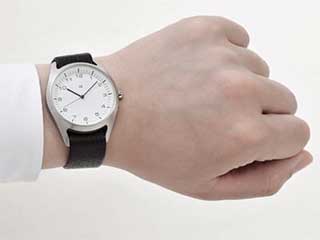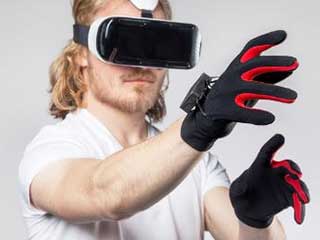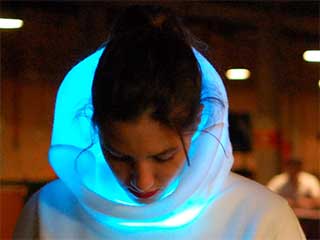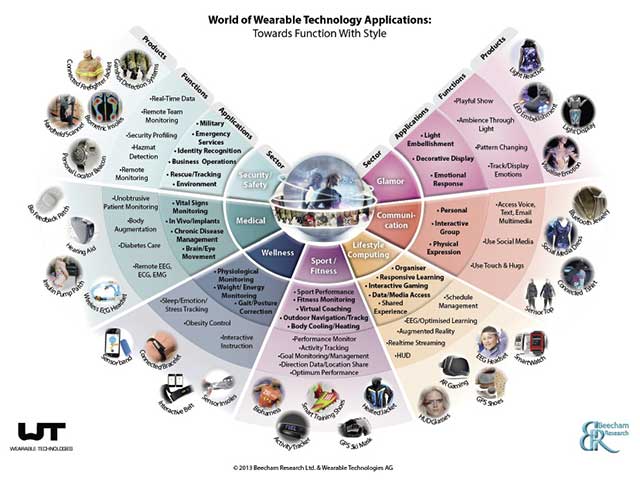Wearable Technology: Pushing the Human Condition to Unknown Limits
It is the strangest thing to an outside observer, watching another person wearing a visor which completely covers their eyes and with one hand, wearing a strange and bulky glove as they wave their arm around making purposeful gestures within their surrounding space.
The glove wearer is engulfed within a virtual world and using a data glove (in a sense wearing a very glorified mouse) as a user interface to interact within the virtual world as seen within the user's head visor. While this is a form of virtual reality (VR) immersion, the VR gear is a subset of a much bigger issue of technical enhancements known as wearable technology.
Wearable technology is a process that could be defined as any technology enhancement to the human condition to improve that person's functionality within a military, industrial, medical, health or social situation. The importance of this process is its “wearability,” allowing the user to capitalize on the device's mobility and technology, and is unencumbered by connecting wires or unwieldy-sized components.
A hearing aid easily demonstrates the value of wearable technology. In the digital/electronic world that surrounds us, the essential elements of these wearable devices is its miniaturization, its data connectivity and it's attachability to one's body. Wearable devices take many forms including data gloves, smart glasses, headsets, smart watches, prosthetics, and full body environmental protection suits, all designed to enhance some part of the wearer's abilities to a higher level of performance.
Animal Skins, Turtle Shells and Leather Hides: The First Wearables
At first glance wearable technology may seem like a modern idea attached to VR headsets, smart watches, Fitbits and other mobile digital devices. However wearable technology has a legacy that exceeds back millennia, back to early Hominids times when cave dwellers began to cover their bodies with animal skins to protect themselves from the harsh weather elements. Animal skins eventually begot clothing. That further evolved through military necessity beginning in ancient China within various warring dynasties where warriors of these armies created some of the first practical armor for battle use. The Shang Dynasty (1600 B.C. - 1046 B. C.) soldiers began by using turtle shells tied together to cover their bodies.
In Europe, eons later during the Middle Ages warriors also conceived of their own versions of extended body protection similar to what the Chinese armies had already developed. Soldiers of that era used thick leather coverings to protect their arms, legs and torso during close up battle confrontations. As the Middle-Ages warfare became more sophisticated and weapons became more intense, the use of armor improved from leather to metal coverings worn from head to toe completely protecting its wearer from immediate injury. The introduction of protective wearable armor developed by both armies despite the difference in time and location of development established the true beginnings of implementing a “wearable technology.”
 |
 |
| Plate Armor | Wristwatches |
In line with the embrace of other early wearable devices, the wristwatch emerged in its early years (1900s) from a status symbol used by the wealthy to a mass commodity worn today by everyone who wants one. The first timepieces developed during the 1700s were very big clocks with complicated clockworks to keep them ticking. Eventually keeping time became important enough that by the early 20th century the clock's mechanisms of gear and balances were miniaturized enough to be wearable on a person's wrist or attached with a chain to their clothes. It was during WW I that wristwatches gained practical use as they were mass-produced for distribution to soldiers for use in synchronizing their movements around the battlefield between artillery barrages and troop deployments.
Clearly as society became more complex, more technology driven and more adoptive of man's presence to his environment, wearable technology has become more of an enabler in how people connect themselves to their work, health and social lives. Given the technological improvements of wearables, these devices in one form or another have become embedded in many aspects of people's lives. In the world of wearable media technology we have the before mentioned VR goggles and data glove, which is not much different than strapping a miniature television across your face for entertainment and educational use. And let's not forget the smartphone which seems permanently attached to most people's presence in a never ending quest to keep in touch with all their social and business acquaintances.
Warehouse Wearable Devices
 Warehouse Wearable Devices
Warehouse Wearable DevicesAs wearable technology becomes more practical, so is it being adopted by industry on an as-needed basis? For example, it has become an important part of warehouse management in regard to inventory processing. Previously in moving inventory between storage and deployment to customers, warehouse workers relied on their vision to identify and count product for storage and shipping purposes. Now as all products have bar code labels, a worker wearing a modified data glove can walk through a product shelving area and carefully waving his or her arm, can scan the products identifying total number of available inventory parts and their locations for further processing.
Wearable Devices for the Final Frontier
 Space Suit
Space SuitSome wearable improvements to the human condition were developed as a form of protection against hostile environments that people are actively engaged in. The desire for deep underwater diving resulted in bulky diving suits allowing people to descend to great underwater depths previous unreachable by unequipped swimmers. In this state, divers acquired extended breathing time, radio communications to the surface, and full body protection against the cold and increasing pressure of being underwater.
Further enhancements were eventually introduced by transforming the diving suit into scuba gear which allowed the diver an even greater flexibility of underwater movement in their deep sea explorations. Environmental wearable protection suits now take many forms from fire suits to spacesuits, all designed to protect and extend a person's presence under the extreme conditions of these various hostile environments.
Wearable technology has evolved to suite many aspects of the human condition including protection, health, fashion and media communications. The biggest area of wearables within the medical community is the variety of prosthetics to replace or compensate for a detrimental medical condition. These wearable enhancements cover a range of devices from eye glasses and hearing aids to pace makers all designed to extend their living situation. Here medical related wearables offer their users mobility, improved health and a sense of empowerment and confidence as they continue to participate within their community.
VR/AR Headgear
 Virtual Reality Headgear and Gloves
Virtual Reality Headgear and GlovesAs virtual reality has emerged as a new forum of media communications, so has the idea of “full immersion” as a unique way of experiencing these virtual worlds. The key to this full immersion is the user wears a head visor which totally surrounds the wearer's visual sense as a completely enclosed experience. While this is mostly directed to the entertainment and gaming markets, a second form of visor experience is augmented reality (AR) which simultaneously combines aspects of a virtual situation within the real world.
Imagine an aircraft mechanic wearing an AR visor and working on a jet engine, and being able to call up specific pages from the engine's tech manual to guide him during his engine repairs. As much as business and education have absorbed computers into their environments, so will their electronic counterparts in wearable headgear become standard tools for use in comparable situations?
Wearable Transplants
As wearable technology continues to evolve there are no limits to how it can adopt to society and human needs. In the area of medical and health wearables, while several body organs have been duplicated with mechanical replacements there are other parts of the body still in research to develop their mechanical or electronic replacement parts. Today we have artificial knees and hips, and one day as freaky as it sounds, we'll have artificial eyes where eventually its operation will be as minor as removing an appendix. Aside from adoptive prosthetics there is also an interest in biometrics were people concerned with their health can wear a Fitbit, which is a health wrist band that allows them to monitor their heart rate, measure sleep quality, how many calories they burn and calculate distances achieved from walking.
As people eagerly seek wearable technology from medical enhancements to blue tooth earbuds, these devices can be distinguished between some of them embedded as permanents implants, while others are temporary (smartphones and smart watches) as fashion statements or used on an “as needed basis.” Wearable technology has also become not only fashionable, but very oriented to fashion wear as various articles of clothing such as shirts, blouses, pants and dresses have become imbedded with lighting using LEDs or electroluminescent accessories to illuminate the clothing giving its user that glowing party look.
Mood Sweater Colors Your Feelings
 Mood Sweater
Mood SweaterThe use of embedded lighting within clothing goes far beyond esthetics, to a form of “emotive fashion” where your emotions can influence the look and color of your clothes. In another wearable technology fashion effort, Sensoree Design Lab (San Francisco, CA) founded in 2010 by Kristin Neidlinger is a company that explores creating interactive emotive displays that extend beyond the bounds of the human body. In Neidlinger's interactivity explorations, she believes “light plays an important part in her work of developing wearable computing to expand an awareness of your body.”
“The first form of communication,” says Neidlinger, “is visual, so it makes sense that light could and should be a component of fashion as well as an expression of your body's presence.” What if you could physically see and identify a person's emotions through visible biofeedback? Here Sensoree had done that by introducing the Mood Sweater, a garment that visually communicates your feelings in a public setting.
The Mood Sweater as designed by Neidlinger is capable of detecting the wearer's mood and representing it visually. How this is done is the sweater has a series of colored LEDs and as well, an embedded hand held sensor system that allows the sweater to detect changes in the wearer's emotional presence. When it does, the sweater changes colors.
The design of the sweater incorporates an over-sized bowl-shaped collar which forms up around the wearer's face. The interior of the bowl-collar contains the LEDs and functions to offer, “instant biofeedback and acts as an external electronic blush for others to see. Located around the larynx, the visual interface replaces speaking, as the wearer’s emotional truths are instantly expressed with color.”
“People's reaction to the sweaters once they understand how they work are usually very impressed that is has behaviors. There is a certain amount of awe,” says Neidlinger. “Some people are a little nervous, about trying it on themselves. Children on the other hand love it, and begin playing games with its color rendering capabilities.”
Wearable Permanence
The bigger question of wearable technology is how far can it be taken as an embellishment of the human condition? Whereas many wearable devices particularly medical wearables have become permanent implants to replace damaged body parts, it is interesting to speculate how much of the human body can be replaced to rehabilitate or improve a person's health and performance. The extent of replacing much of a human's original body organs with wearable medical counterparts is less the realm of science fiction and more a consideration of things to come.
The implementation of using wearables opens an interesting door to human evolution and its abilities in adopting to its surrounding socio/technological environment. In today's world, modern wearables are technological improvements that over time may transform from mechanical/digital processes to genetically enhanced “augmented wearables” embedded within one's DNA. Thus genetic engineering could become the ultimate wearable modification in the human body for improved sight, a stronger heart or a stronger defense against cancer or other threats to the human body.
An American Cyber Scientist Ray Kurzweil has addressed this idea in what he calls Transhumanism which is a process that evolves humans by fundamentally improving the human condition through varied available technologies to eliminate aging and enhance human intellectual and physical capacities. Clearly medical wearables could very well be a stepping-stone along this path.
One might consider it a far stretch from wearable technology to Transhumanism, it does however have to start somewhere. Already a vast number of people willingly wear blue tooth ear buds and almost an equal number of consumers are eagerly waiting for affordable VR headsets, both detachable wearables. It is only a matter of time before these detachable and other similar devices, become permanent features of the human body. Here wearable technology will be less a fashion statement and more a permanent part of a new kind of human condition.
Inevitably human evolution will be not so much the whim of nature as much as the inventive inspiration of human intervention of taking the human body and improving it as much as possible within the limits of medical ethics, societal and practical acceptance.






